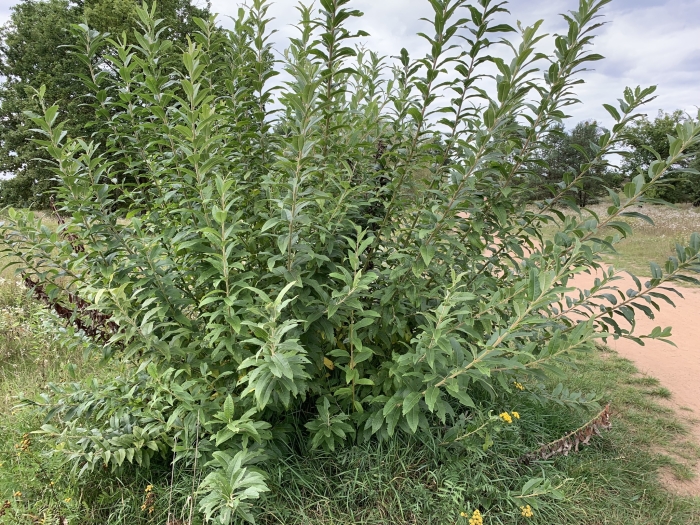Smith’s Willow
(Salix ×smithiana)
Smith’s Willow (Salix ×smithiana)
/
/

© Katrin Simon
CC BY 4.0
Image By:
© Katrin Simon
Recorded By:
Copyright:
CC BY 4.0
Copyright Notice:
Photo by: © Katrin Simon | License Type: CC BY 4.0 | License URL: http://creativecommons.org/licenses/by/4.0/ | Uploader: katrin_simon | Publisher: iNaturalist |


















Estimated Native Range
Summary
Salix ×smithiana, commonly known as Smith’s Willow or Smith’s Hybrid Willow, is a deciduous hybrid shrub resulting from the cross between Salix caprea (goat willow) and Salix viminalis (basket willow). It is characterized by a rapid growth rate and can reach a height of 20-50 feet (6-15 meters) with a similar spread of 20-30 feet (6-9 meters). The plant exhibits a bushy form with multiple stems and bears yellow catkins that bloom in early spring, providing an early source of pollen for bees. The catkins are followed by the development of small capsules containing numerous seeds. Smith’s Willow is particularly noted for its vigorous growth and adaptability to wet conditions.
Smith’s Willow thrives in riparian zones, wetlands, and other moist environments, making it an excellent choice for erosion control and streambank stabilization. It is also used for biomass production and as a windbreak due to its fast growth. In cultivation, it requires high amounts of water and can tolerate a range of soil types, including clay, loam, and sandy soils, with medium to slow drainage. It is best positioned in full sun or part shade to achieve optimal growth. While it is valued for these uses, it is important to be aware of its potential invasiveness outside its native range, as it can spread aggressively through both root suckers and seed dispersal.CC BY-SA 4.0
Smith’s Willow thrives in riparian zones, wetlands, and other moist environments, making it an excellent choice for erosion control and streambank stabilization. It is also used for biomass production and as a windbreak due to its fast growth. In cultivation, it requires high amounts of water and can tolerate a range of soil types, including clay, loam, and sandy soils, with medium to slow drainage. It is best positioned in full sun or part shade to achieve optimal growth. While it is valued for these uses, it is important to be aware of its potential invasiveness outside its native range, as it can spread aggressively through both root suckers and seed dispersal.CC BY-SA 4.0
Plant Description
- Plant Type: Shrub, Tree
- Height: 20-50 feet
- Width: 20-30 feet
- Growth Rate: Rapid
- Flower Color: N/A
- Flowering Season: Spring
- Leaf Retention: Deciduous
Growth Requirements
- Sun: Full Sun, Part Shade
- Water: High
- Drainage: Medium, Slow
Common Uses
Bank Stabilization, Erosion Control, Water Garden
Natural Habitat
Riparian zones and wetlands
Other Names
Common Names: Smith’s Hybrid Willow
Scientific Names: Salix ×smithiana , Salix caprea ssp. caprea x viminalis , Salix caprea ssp. caprea × viminalis , Salix caprea subsp. caprea x viminalis , Salix caprea subsp. caprea × viminalis , Salix caprea × viminalis , Salix holosericea var. nitens , Salix smithiana var. argentata , Salix viminalis subsp. semiviminalis , Salix viminalis var. latifolia
GBIF Accepted Name: